
A burial tree or burial scaffold is a tree or simple structure used for supporting corpses or coffins. They were once common among the Balinese, the Naga people, certain Aboriginal Australians, and some North American First Nations. [1]

A burial tree or burial scaffold is a tree or simple structure used for supporting corpses or coffins. They were once common among the Balinese, the Naga people, certain Aboriginal Australians, and some North American First Nations. [1]
A number of Native Americans used a burial tree as the last resting place for a dead relative, either as the general rule (along with a scaffold) or as an alternative to a grave. [2] : 87 [3] : 99
The corpse was wrapped up carefully in a robe or blankets and either placed in a fork of the tree [4] : 67 or tied to a heavy branch. [5] : 83 Both grown persons and small children were laid to rest in this way. [5] : 83, 385 A burial tree could carry more than one dead. [5] : 112 Maximilian zu Wied saw burial trees with red painted trunk and branches among the Assiniboine Indians. [6] : 45–46 It seems any tree was proper. Cottonwood [5] : 112 is mentioned by travelers on the great plains, as well as pine [5] : 83 and cedar. [7] : 69 The dead could be placed from around six feet up in the tree to close to the top. [5] : 112 Some of the belongings of the deceased were often placed near the corpse.
A burial scaffold was usually made of four upright poles or branches, forked at the top. This foundation carried a sort of bier, where the dead body was laid to rest out of reach of wolves. The preferred location was on a hill. [5] : 83 Relatives would often place some of the belongings of the dead on the platform or around the scaffold. [2] : 87
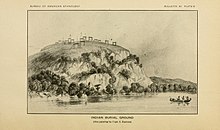

The poles reached "a mans height above ground" (six to eight feet). [2] : 87 [8] : 102 [9] : 20 An extraordinarily high scaffold carried the corpse of a Sisseton Sioux an estimated 18 feet above the ground. [6] : 23 One scaffold described had poles painted black and red in horizontal stripes. [10] : 75 An 1849 Nebraska traveler saw a scaffold made of lodge poles rested against each other at the top and with two biers halfway down. [8] : 102
An Ojibwe man would get his arms and other personal effects with him on the scaffold along with food, eating utensils and tobacco. [2] : 87 This practice may have been used only as a temporary solution when death occurred far from the common burial ground with graves and markers. Birch bark served as an option to a body wrapping of skin among the Ojibwe. [11] : 76
In the 18th century, the Choctaw placed the dead on a scaffold as a first step in a burial process. Months later, bone pickers stripped the flesh from the bones. The skeleton was then cleaned and piece by piece put in a sort of small coffin and lastly placed in the Indian city's special bone house. [12] : 94
The personal effects of an Indian woman were laid with her in an open pine box (likely made by a carpenter) situated on a scaffold put up near Fort Laramie in 1866. The heads and tails of her two ponies were fastened to respectively the eastern and the western poles. [9] : 21
Among the Crow, the dead was wrapped in a robe and placed on the bier with the feet to the east. Much later, the bones could be collected and placed in a rock gap. [4] : 67
The Mandan Indians positioned the dead body on the scaffold with the feet to the southeast, so the spirit was directed to the old Mandan country around Heart River, North Dakota. [3] : 99 With the scaffold rotten and on the ground, the bones were wrapped in a hide and buried in the refuse at the Mandan village or in a riverbank. [3] : 101 The skull would be placed among other clan skulls arranged in circles on the ground near the scaffolds. [3] : 100 Newborns, who died unnamed, were not considered members of the society and hence placed in trees (or buried) away from the common burial ground outside the village. [3] : 98
During winter, the Ponca Indians would often substitute a grave with a scaffold because the ground was frozen. [13] : 155 A Lakota summed up the reasons why a high scaffold outdid a grave, "(1) Animals or persons might walk over the graves; (2) the dead might lie in mud and water after rain or snow; (3) wolves might dig up the bodies and devour them." [14] : 486 With the dead placed on a scaffold or in a tree, the relatives could easily talk to the deceased. [15] : 571

Burial, also known as interment or inhumation, is a method of final disposition whereby a dead body is placed into the ground, sometimes with objects. This is usually accomplished by excavating a pit or trench, placing the deceased and objects in it, and covering it over. A funeral is a ceremony that accompanies the final disposition. Evidence suggests that some archaic and early modern humans buried their dead. Burial is often seen as indicating respect for the dead. It has been used to prevent the odor of decay, to give family members closure and prevent them from witnessing the decomposition of their loved ones, and in many cultures it has been seen as a necessary step for the deceased to enter the afterlife or to give back to the cycle of life.
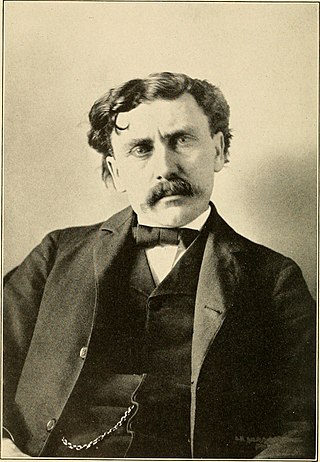
James Mooney was an American ethnographer who lived for several years among the Cherokee. Known as "The Indian Man", he conducted major studies of Southeastern Indians, as well as of tribes on the Great Plains. He did ethnographic studies of the Ghost Dance, a spiritual movement among various Native American culture groups, after Sitting Bull's death in 1890. His works on the Cherokee include The Sacred Formulas of the Cherokees (1891), and Myths of the Cherokee (1900). All were published by the US Bureau of American Ethnology, within the Smithsonian Institution.
In archaeology and anthropology, the term excarnation refers to the practice of removing the flesh and organs of the dead before burial. Excarnation may be achieved through natural means, such as leaving a dead body exposed to the elements or for animals to scavenge; or by butchering the corpse by hand. Following excarnation, some societies retrieved the excarnated bones for burial. Excarnation has been practiced throughout the world for hundreds of thousands of years. The earliest archaeological evidence of excarnation is from the Awash River Valley in Ethiopia, 160,000 years ago. Examples of excarnation include "sky burials" in parts of Asia, the Zoroastrian "Tower of Silence", and Native American "tree burials". Excarnation is practiced for a variety of spiritual and practical reasons, including the Tibetian spiritual belief that excarnation is the most generous form of burial and the Comanche practical concern that in the winter the ground is too hard for an underground burial. Excarnation sites are identifiable in the archaeological record by a concentration of smaller bones, which would be the bones that would be the easiest to fall off the body, and that would not be noticed by practitioners of excarnation.

The Hidatsa are a Siouan people. They are enrolled in the federally recognized Three Affiliated Tribes of the Fort Berthold Reservation in North Dakota. Their language is related to that of the Crow, and they are sometimes considered a parent tribe to the modern Crow in Montana.

Arikara, also known as Sahnish, Arikaree, Ree, or Hundi, are a tribe of Native Americans in North Dakota. Today, they are enrolled with the Mandan and the Hidatsa as the federally recognized tribe known as the Mandan, Hidatsa, and Arikara Nation.
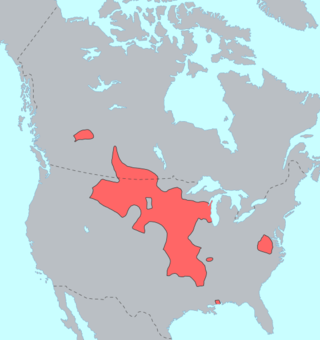
The Western Siouan languages, also called Siouan proper or simply Siouan, are a large language family native to North America. They are closely related to the Catawban languages, sometimes called Eastern Siouan, and together with them constitute the Siouan (Siouan–Catawban) language family.
Mandan is an extinct Siouan language of North Dakota in the United States.

The Mandan are a Native American tribe of the Great Plains who have lived for centuries primarily in what is now North Dakota. They are enrolled in the Three Affiliated Tribes of the Fort Berthold Reservation. About half of the Mandan still reside in the area of the reservation; the rest reside around the United States and in Canada.
Nakota is the endonym used by those Native peoples of North America who usually go by the name of Assiniboine, in the United States, and of Stoney, in Canada.
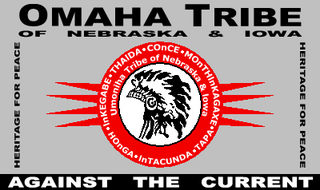
The Omaha are a federally recognized Midwestern Native American tribe who reside on the Omaha Reservation in northeastern Nebraska and western Iowa, United States. There were 5,427 enrolled members as of 2012. The Omaha Reservation lies primarily in the southern part of Thurston County and northeastern Cuming County, Nebraska, but small parts extend into the northeast corner of Burt County and across the Missouri River into Monona County, Iowa. Its total land area is 307.03 sq mi (795.2 km2) and the reservation population, including non-Native residents, was 4,526 in the 2020 census. Its largest community is Pender.

The Criel Mound, also known as the South Charleston Mound, is a Native American burial mound located in South Charleston, West Virginia. It is one of the few surviving mounds of the Kanawha Valley Mounds that were probably built in the Woodland period after 500 B.C. The mound was built by the Adena culture, probably around 250–150 BC, and lay equidistant between two “sacred circles”, earthwork enclosures each 556 feet (169 m) in diameter. It was originally 33 feet (10 m) high and 173 feet (53 m) in diameter at the base, making it the second-largest such burial mound in the state of West Virginia. This archaeological site is listed on the National Register of Historic Places.
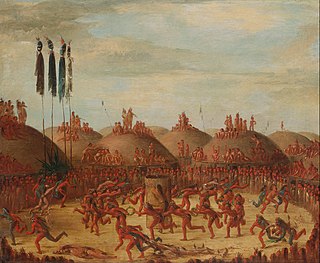
Like-a-Fishhook Village was a Native American settlement next to Fort Berthold in North Dakota, United States, established by dissident bands of the Three Affiliated Tribes, the Mandan, Arikara and Hidatsa. Formed in 1845, it was also eventually inhabited by non-Indian traders, and became important in the trade between Natives and non-Natives in the region.
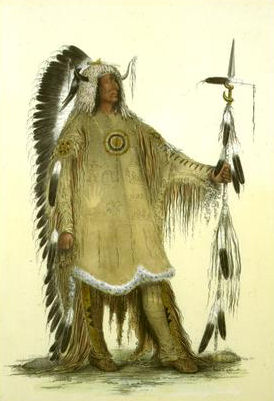
Mato-tope was the second chief of the Mandan tribe to be known as "Four Bears," a name he earned after charging the Assiniboine tribe during battle with the strength of four bears. Four Bears lived in the first half of the 19th century on the upper Missouri River in what is now North Dakota. Four Bears was a favorite subject of artists, painted by George Catlin and Karl Bodmer.

James Owen Dorsey was an American ethnologist, linguist, and Episcopalian missionary in the Dakota Territory, who contributed to the description of the Ponca, Omaha, and other southern Siouan languages. He worked for the Bureau of American Ethnology of the Smithsonian Institution from 1880 to 1895, when he died young of typhoid fever. He became known as the expert on languages and culture of southern Siouan peoples, although he also studied tribes of the Southwest and Northwest.
Nanza is the Ponca name for what is now called Ponca Fort. It was a fortified village built by the Ponca in the vicinity of present-day Niobrara, Nebraska, USA, in circa 1700 and occupied until about 1865.
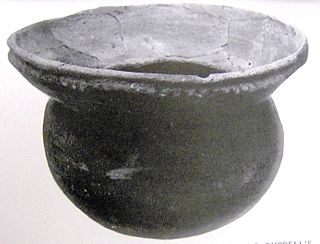
Bussell Island, formerly Lenoir Island, is an island located at the mouth of the Little Tennessee River, at its confluence with the Tennessee River in Loudon County, near the U.S. city of Lenoir City, Tennessee. The island was inhabited by various Native American cultures for thousands of years before the arrival of early European explorers. The Tellico Dam and a recreational area occupy part of the island. Part of the island was added in 1978 to the National Register of Historic Places for its archaeological potential.

Fewkes Group Archaeological Site, also known as the Boiling Springs Site, is a pre American history Native American archaeological site located in the city of Brentwood, in Williamson County, Tennessee. It is in Primm Historic Park on the grounds of Boiling Spring Academy, a historic schoolhouse established in 1830. The 15-acre site consists of the remains of a late Mississippian culture mound complex and village roughly dating to 1050-1475 AD. The site, which sits on the western bank of the Little Harpeth River, has five mounds, some used for burial and others, including the largest, were ceremonial platform mounds. The village was abandoned for unknown reasons around 1450. The site is named in honor of Dr. J. Walter Fewkes, the Chief of the Bureau of American Ethnology in 1920, who had visited the site and recognized its potential. While it was partially excavated by the landowner in 1895, archaeologist William E. Myer directed a second, more thorough excavation in October 1920. The report of his findings was published in the Bureau of American Ethnology's Forty-First Annual Report. Many of the artifacts recovered from the site are now housed at the Smithsonian Institution. It was added to the National Register of Historic Places on April 21, 1980, as NRIS number 80003880.

The Freel Farm Mound Site (40AN22) is an archaeological site and burial mound of the Late Woodland period located on the Oak Ridge Reservation in Oak Ridge, Tennessee. The site was excavated in 1934 as part of the Norris Basin Survey by the Tennessee Valley Authority using labor from the Civil Works Administration under the supervision of T.M.N. Lewis. Important finds of the excavation include 17 burials and a few artifacts. The artifacts and records from the fieldwork are held by the McClung Museum in Knoxville, Tennessee.
The Freel Farm Mound Site (40AN22) is an archaeological site and burial mound of the Woodland cultural period located on the Oak Ridge Reservation in Oak Ridge, Tennessee. The site was excavated in 1934 as part of the Norris Basin Survey by the Tennessee Valley Authority using labor from the Civil Works Administration under the supervision of T.M.N. Lewis. Important finds of the excavation include 17 burials and a few artifacts. The artifacts and records from the fieldwork are held by the McClung Museum in Knoxville, Tennessee.
The Dhegihan migration and separation was the long journey on foot by the North American Indians in the ancient Hą́ke tribe. During the migration from present-day Illinois/Kentucky and as far as Nebraska, they gradually split up into five groups. Each became an independent and historic tribe. They are the Omaha, Ponca, Kaw or Kansa, Osage and Quapaw.